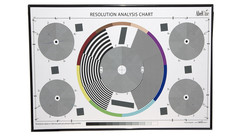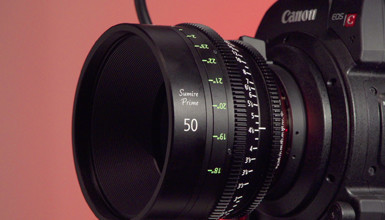The Canon Sumire lenses are actually quite unique, and can really add a distinctive look to your project. I found the skin tones to be consistent with the well-known “Canon look.” However, the lenses have a few more unique characteristics that I found extremely pleasing, especially when paired with high resolution digital formats. All of this footage was shot on a RED at 8K 8:1. Overall I really fell in love with these lenses for their unique bokeh, warm skin tones, and their natural, organic feel.
Watch my sample footage and learn more, below, about some technical and aesthetic aspects we typically evaluate when testing a new lens.
Color, Contrast & Breathing
The color of the Sumires is consistent with other Canon cinema lenses. I loved the warm skin tones, similar to the Canon look we all know and love. The colors popped nicely as well. The Sumire’s contrast was very natural and organic, adding a lot of life to the high resolution format. Very little to no breathing is discernable in the image.
Resolution
To test how well the lens captured resolution, I used one of the Cameo Resolution Analysis Charts. I set up the camera at 10’ away and shot all the way open in order to see how it performed under challenging situations. I also filmed each lens at T2.8, or close to one stop closed, to see performance. While these lenses do cover full format and have sharp resolution, you can notice some fall off in the corners, adding to their unique look and really focusing the eye of the audience
Bokeh
The bokeh is absolutely beautiful with the Sumire lenses, I especially loved the 50mm. Most noticeable on the longer focal lengths, the bokeh is very circuluar in the center but a bit more oval on the left and right sides of the frame. This was less visible at deeper stops.
Build & Design
From afar, the Sumire lenses look very similar to the Canon CN-E (released only in EF mount), only they are PL mount. The front diameter is 114mm, which is a standard size and same as the CN-Es. They also feature a phosphorescent coating, so the focus distance and iris are visible in the dark. They are very compact, lending nicely to gimbal, Steadicam, and handheld situations.














AbelCine encourages comments on our blog posts, as long as they are relevant and respectful in tone. To further professional dialog, we strongly encourage the use of real names. We reserve the right to remove any comments that violate our comment policy.
AbelCine publishes this blog as a free educational resource, and anyone may read the discussions posted here. However, if you want to join the conversation, please log in or register on our site.
We use Disqus to manage comments on this blog. If you already have a Disqus account registered under the same email as your AbelCine account, you will automatically be logged in when you sign in to our site. If not, please create a free account with Disqus using the same email as your AbelCine account.